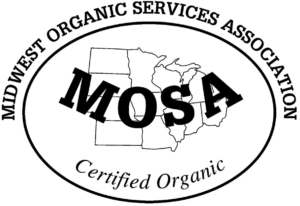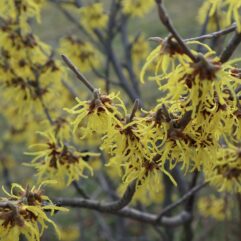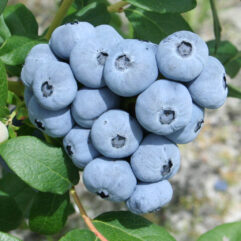

Growing Organic Berry Plants:
Managing Annual Fertility
for Your Berry Plants
Caring for your berry plants
Here is a list of seasonal duties that we perform (well, we try
to perform them, but sometimes weather and life get the better of
our intentions) on our farm, ensuring healthy and productive plants.
Feeding the Blueberry and Raspberry Plant:
Too little or too much fertilizer can be bad for any fruit
producing plant, as it can result in nutrient imbalances and
toxicity. Many of you who order and correspond with me have
asked me what we do here at our farm, so I am going to put it here
for all to see. We’ve spent a while playing around with
different formulations and timing of applications, and feel we have
a pretty good system. So, here is our fertility schedule for our
blueberry plants (click HERE to jump down to the care for raspberry plants).
Growing Blueberries Organically:
Annual Fertilization Schedule
Early to mid-spring, usually when the daffodils are in full
bloom, we top-dress our blueberries with half to 1 pound
Re-Vita Pro fertilizer (5-4-3), depending upon the size and age of
the plant (3-5 years old get 0.5#, 6 yrs. and older get 1 pound, or
roughly 3 cups). This is done by sprinkling the fertilizer
over the growing zone of the plant (which for us is a 3’x3′ area).
In late May to June, I have found that repeating the top-dressing in
spring (at a half-rate) encourages larger berries as well as better
flowering the following year. If you are also using the liquid
feeding schedule we recommend, this second top-dressing is not
necessary.
Any balanced, organic fertilizer will do. If you use alfalfa
meal or pellets (instead of the granular fertilizer), the
top-dressing amount should be 1# for young plants (up to 5 years)
and 2# for older plants (6 years and older). The alfalfa should be
applied under the mulch of the blueberry, to keep it from spoiling.
After blossoms have fallen, we begin the liquid feeding of our
plants. This is given to them once a month (or at a half rate
once every two weeks, which has seemed to benefit the plants more
than the single monthly dose) through August.
It is delivered though drip or hose line, and is applied to the root
zone (during fruiting) and foliage (from bloom to green berry, then
post-harvest).
Liquid Fertilizer Recipe
For 1 gallon of mixture, add these amounts to 1 gallon of water:
Neptune’s Harvest Fish Fertilizer (2-4-1)…….2 Tbsp.
OR Alaska Fish Fertilizer (5-1-1)
Maxicrop or other kelp (liquid)………………½ Tbsp.
blackstrap molasses……………………………½Tbsp.
Each plant can receive enough to get good saturation, but don’t
over-water. We usually irrigate the day before applying the
liquid fertilizer mix, or apply after a rain shower if it fits the
schedule. Usually on mature plants they get a 3-5 gallon dose,
younger plants less. If you planted a blueberry from us last
year, it could get 1-2 gallons of this mix, depending upon its size
(lowbush less, highbush more). Quart size plants from the
starter collections would get about a gallon per application.
If you would like to give the plants a foliar feeding of this as
well, go ahead and just spray them to dripping with the above
solution. However, I would advise using the liquid mix only on
the root zone of mature plants with fruits that are ripening
(so the berries are not “fishy” tasting). After harvest is
done, you can begin foliar treatments. I have found increased
production and vigor in our plants
the following year when treated with this mix up to the end of
August.
In areas of the country with alkaline soils and water, I strongly
recommend using the soil-less mix method for planting and growing
blueberries.
Top dressing the planting area each year with a shovel or two of
sphagnum peat moss will help maintain acidity.
The last aspect of a good fertility schedule is mulching, which
eventually breaks down to provide nutrients to the plants not found
in the purchased fertilizers (in fact, one of the facets of using
the fish fertilizer is to add nitrogen to the mulch so microbes can
break it down more effectively and release those nutrients for your
plants use). Whenever we can, we use shredded oak or maple
leaves, and pine needles (these are just the best, so those of you
in the south take advantage of the baled pine needles often sold at
local nurseries or garden centers). Shredded pine bark will
last two to three seasons, but should be dressed if you start to
see bare patches in its cover (excellent places for weeds to get in,
and they will grow like crazy if they get started). Mulches
should be at least 3 inches thick for blueberry plants, and coarse
so that water percolates through the mulch easily (that is why the
oak leaves need to be shredded or chopped, otherwise they deflect
water from the growing area).
That is it, rather simple, yet the old saw “A stitch in time
saves nine” is true as ever. Proper care and feeding results
in the best production and health for your plants.
Pruning Your Blueberry Plants
I am only going to give some basic precepts here, as there are
many fine books and references (which I have always used and found
to be effective) available.
First, every spring, look at the bush and prune away any dead or
broken branches or stems.
Second, you want to remove any twiggy, horizontal growth near
the base of the plant. These stems will never result in
anything, and they just sap energy away from the plant, reducing
productivity.
Last, you want to keep the bush open, so sunlight can penetrate
all the way through the bush. This generally means getting rid
of excessively twiggy branches and stems, which usually only produce
smaller berries anyway. This may decrease your yield slightly,
but will increase the size and quality of your berries, as well as
encourage new growth from the crown.
For the plants you purchase from us, you should only have to do the
first two steps during the three years after purchase. The
following years may see the need for the third step, as well as
regenerative pruning.
For regenerative pruning I will refer you to Barbara Bowling’s book
The Berry Growers Companion, which is a great
reference for care and management of many berry species. This
is a great all around book for the backyard grower.
For those of you desiring a more in depth book specifically about
highbush blueberries, Dr. Robert E Gough’s book
The Highbush Blueberry and Its Management
is excellent. Dr. Gough is renowned for his studies and
illumination in the care of highbush blueberries. The book,
however, is very much written for larger scale, commercial
production (non-organic), but is still filled with information
useful to the small or backyard grower that desires more technical
insight.
Growing Raspberries Organically:
Raspberry Care Schedule
Generally, blackberries and raspberries require less attention to
fertility than other crops, but a good schedule does increase their
productivity.
In late April, usually when the redbud and serviceberry are in
bloom, we top-dress our raspberries at 1/4 pound Re-Vita
Pro fertilizer (5-4-3) per foot row, or a half-pound per 3′ diameter
mound.
The next round of fertilizer will occur right at blossom time, at
half the rate listed above. You can also start the liquid
feeding schedule we use on the blueberries once the canes are up and
growing (for fall bearing raspberries) or have sprouted and begun
flowering (for summer raspberries and blackberries).
Suspend any foliar liquid feeding about 2 weeks before the
berries are beginning to ripen. I’ve found increased vigor and
yield, better pest and disease resistance, and less winter-cane kill
in our brambles when they receive the liquid fertilizer treatment up
to when the daytime temps are consistently less than 60 degrees
(usually mid-October here in Brown Co., IN).
A lot of places and books warn against mulching raspberries, but
I have had good luck with it. The key, I think, has to do with
the type of mulch. Use a coarse mulch, like pine nuggets or
straw, that dries out readily and doesn’t mat. Things to
avoid using are grass clippings, un-shredded
leaves, hay (filled with weed seeds…believe me!), hardwood bark
mulch, and wood chips. Grass is the worst enemy in a patch of
raspberries, so make sure you don’t let any get started. Wheat
straw will have wheat coming up in your patch, but just cut it out
at the base and that will do it in (wheat is not perennial).
If you can find rye straw, it’s great, and usually seedless.
We usually mulch our patches every other year, after we see
emergence and thin the canes. Fertilize with the granular
material right before mulching, if you can. Remember that late
is better than never, and if you don’t get around to mulching and
fertilizing them until May (late), they will totally appreciate the
attention.
Heavy Soils and Brambles
We have very heavy soil here in County Brown, IN, and while
that’s a good thing during droughts, it can be a killer in extremely
wet weather. Through trial and error (and error and error..),
we’ve found a way to strike a balance between weather and soil
conditions so that our brambles can be very successful.
Ridge and Mound Planting
The most susceptible brambles to seasonally wet soils are the red
raspberries, especially the summer red raspberries. Yet, we
get very reliable crops every year, as we plant in ridges (or
mounds, if you have just a few plants here and there). In a
row 18″ to 24″ wide, we have a gradual rise to the middle of the
row, so that the above “grade” height of the ridge is 6-8″.
That little bit of increase above grade seems to do wonders for our
production, with ridged plantings giving nearly twice the amount of
berries in wet years as non-ridged plantings. For mounds 3′ across,
the same applies: a gentle rise to 6-8″ above grade.
Of course, in dry weather, you’ll want to have an irrigation line down,
but that is something you should be prepared to provide anyway (we
usually soak the row with 2 gallons per foot row, applied at
half-gallon per hour through drip lines during hot, dry weather,
twice per week).
Blackberries, black and purple raspberries, and the Anne Golden
fall raspberry, do not seem to benefit nearly as much as the red
raspberries do from this technique. The Lauren red raspberry
really appreciates the ridge method, and seems to require it for
best production.
Pruning your Brambles
Black and Purple raspberries, and hardy
blackberries (all floricane producing brambles)
These varieties have a different growth habit than the red
raspberries. They arise from a crown, with 5-10 canes arising on a
mature plant. Fruiting occurs on the laterals that develop on these canes.
Pruning the plants 3 times during the year will help to make
a sturdy and self-supporting plant, without the need for a trellis.
In Mid to Late Winter (Feb-March), on
established 2 year and older plants: Prune the
laterals of the floricanes, which will help with larger fruit, more
air circulation, and a lower incidence of rot in the upcoming
season. Prune the laterals of black raspberries to 7-9 buds, the
purple raspberries 8-12, and erect blackberries 18”-24”.
Early Summer Tipping (Late May-June) on
primocanes:
Tipping is when you are removing 2 to 3 inches of the tips from the
growing primocanes. This is done to help stimulate lateral growth
and branching on the primocane (for flowering and fruiting next
year), and needs to be done early so that the plant has enough time
to grow strong laterals. Tip black raspberry and purple raspberry
primocanes when they are about 3-4’ feet high, and erect blackberry
primocanes at 4-5’ high (in extremely windy areas, or
where one has experienced blow-over of blackberry canes, try
tipping blackberry canes at three feet).
All the canes on a bramble don’t grow at the same rate, so you
will have to go back and check on slower growing canes.
This is also the time to select the strongest primocanes for
next year’s season. It is good practice to pick the strongest 5-8 canes
on a mature plant, and remove the rest. Further spacing between plants
will allow you more canes per plant.
Plants grown in their own 2’x3’ bed could have up to 10
canes, as long as they had ample air flow around the bed.
You can also try trimming some at lower or taller heights,
and observe the results. They may be better for your needs.
Late Summer Culling (July-Fall) of spent
floricanes: After the floricane is done
fruiting, it will begin to die back.
At this time, you want to use really sharp loppers or pruners
and remove the floricane all the way down to ground level.
Don’t prune into the crown, so if it is tight, it is better
to leave a stub than risk damaging the crown.
After removing the cane, burn or dispose of it away from your
growing area. This will ensure longevity in your bramble stand,
and generally increase the vigor of the stand so that it can endure
for over 12 years, and maybe longer.
Pruning Red Raspberries
Red raspberries have two types: primocane producing and floricane
producing. Management is different for each of these types.
I will discuss floricane types first.
Pruning floricane producing red raspberries
Most of the red raspberries of this type can be grown with a
trellis for higher yields, or without a trellis for slightly lower
yields. Managing with a trellis allows a taller cane to
develop, and therefore more potential for fruiting. Shorter
canes allow for easier pruning, no wires, and sturdy canes that can
withstand storms.
For shorter cane management, tip the primocanes in early summer when
they reach about 3′ tall. You may need to go back and tip some
of the terminal laterals back to 3.5-4′ in late summer, if they are
growing vigorously.
For taller cane management with a trellis, tip the primocanes in
early summer when the reach about a 12-18″ above the top wire of
your trellis. No need to go back and prune any terminal
laterals that may have grown up another foot.
In late winter, go through and thin the canes to the strongest,
thickest, most robust looking. You can have between 2-4 canes
per square foot of growing area. Remember, red raspberries
will send out rhizome-like roots and send up new shoots many feet
from the original mother plant. Tie the canes to the trellis
wire if you are using them.
After fruiting has occurred on these floricanes, they can be cut
away from the plant. Prune as low as you can with out getting into
the crown of the plant. The new primocanes will have been
growing by this time, and will be ready for tipping and preparation
for next years harvest.
Pruning Primocane producing red raspberries
These are very simple to prune. Essentially, you will have a
trellis wire, as you will do no primocane tipping on these
raspberries. The taller the plants grows, the more yield it will
provide, and the longer fruiting period. As the primocane
grows from the crown of the plant, tie it to the trellis wire or
stake when it is tall enough. The plant will flower by
midsummer or early fall, and yield until frost. After the
canes have gone dormant (usually by Thanksgiving here in IN), you
can cut them to the ground. This can be done from early winter to
early spring. Leave no stubs, but do not cut into the soil, or
you may damage the crown. I will note here that primocane
types can be grown as a floricane type, in that their overwintered
primocanes (which fruited their first year) will also flower in
early summer. BUT, the overall yield and quality will be less than
if they were managed just for their primocane crop.



